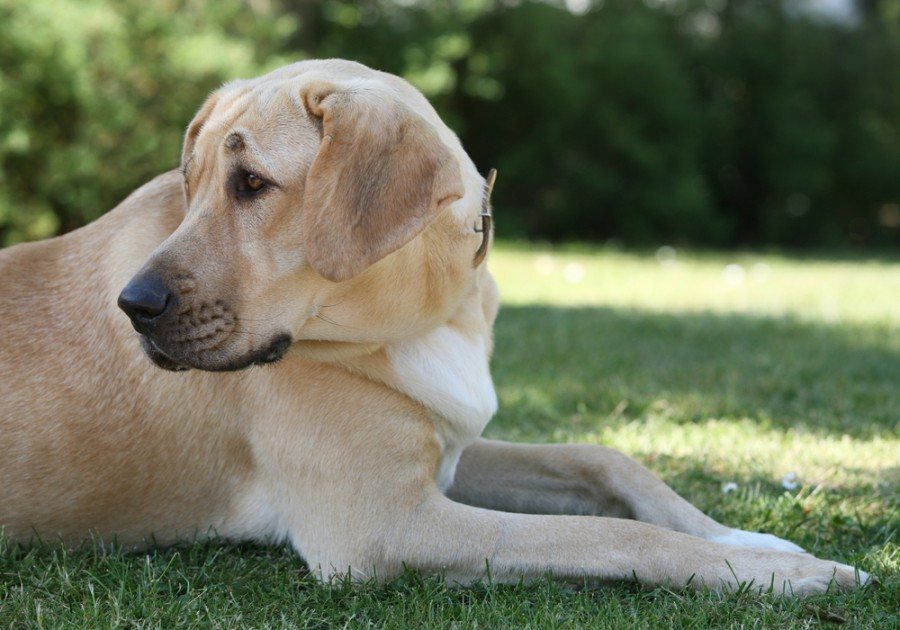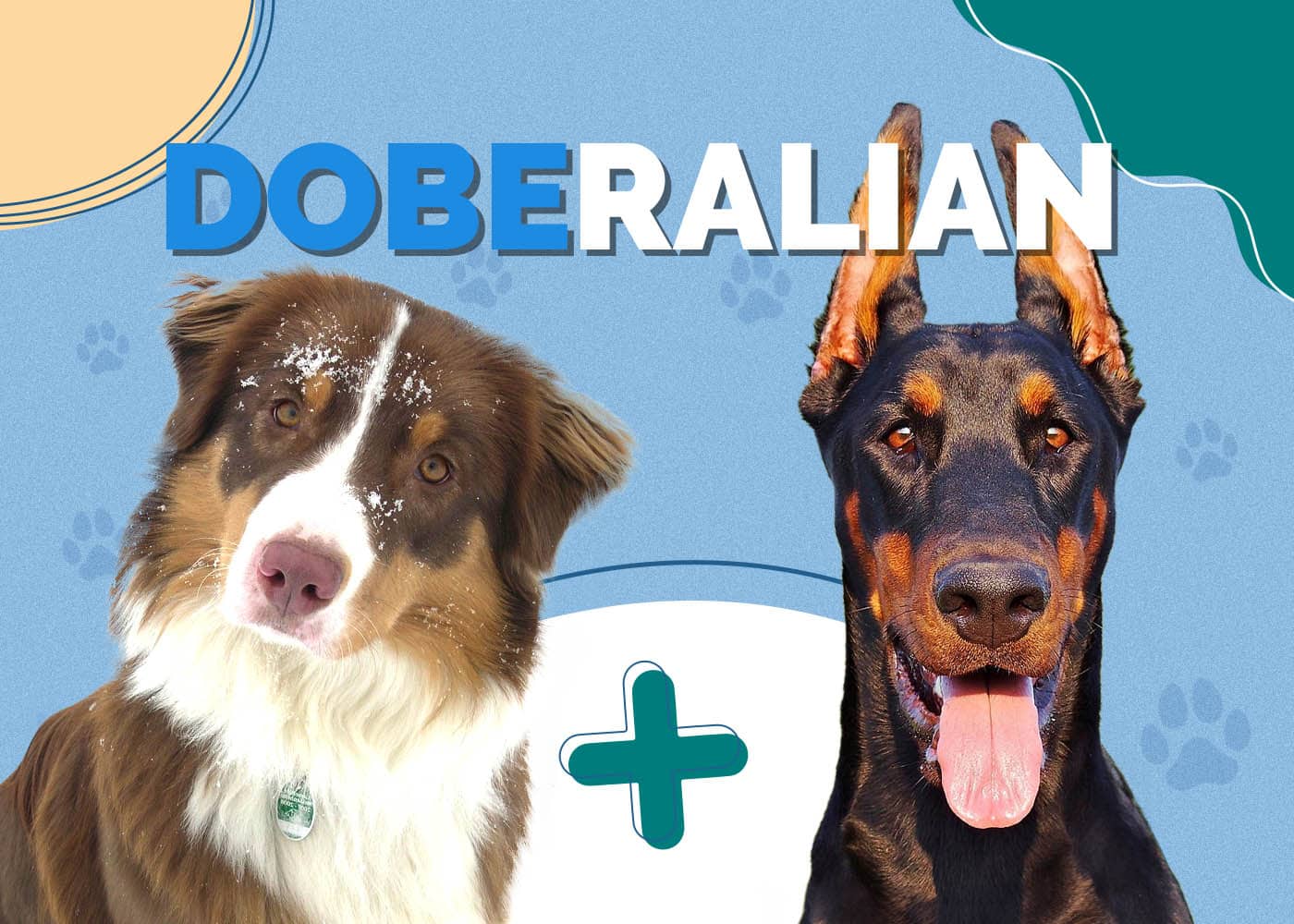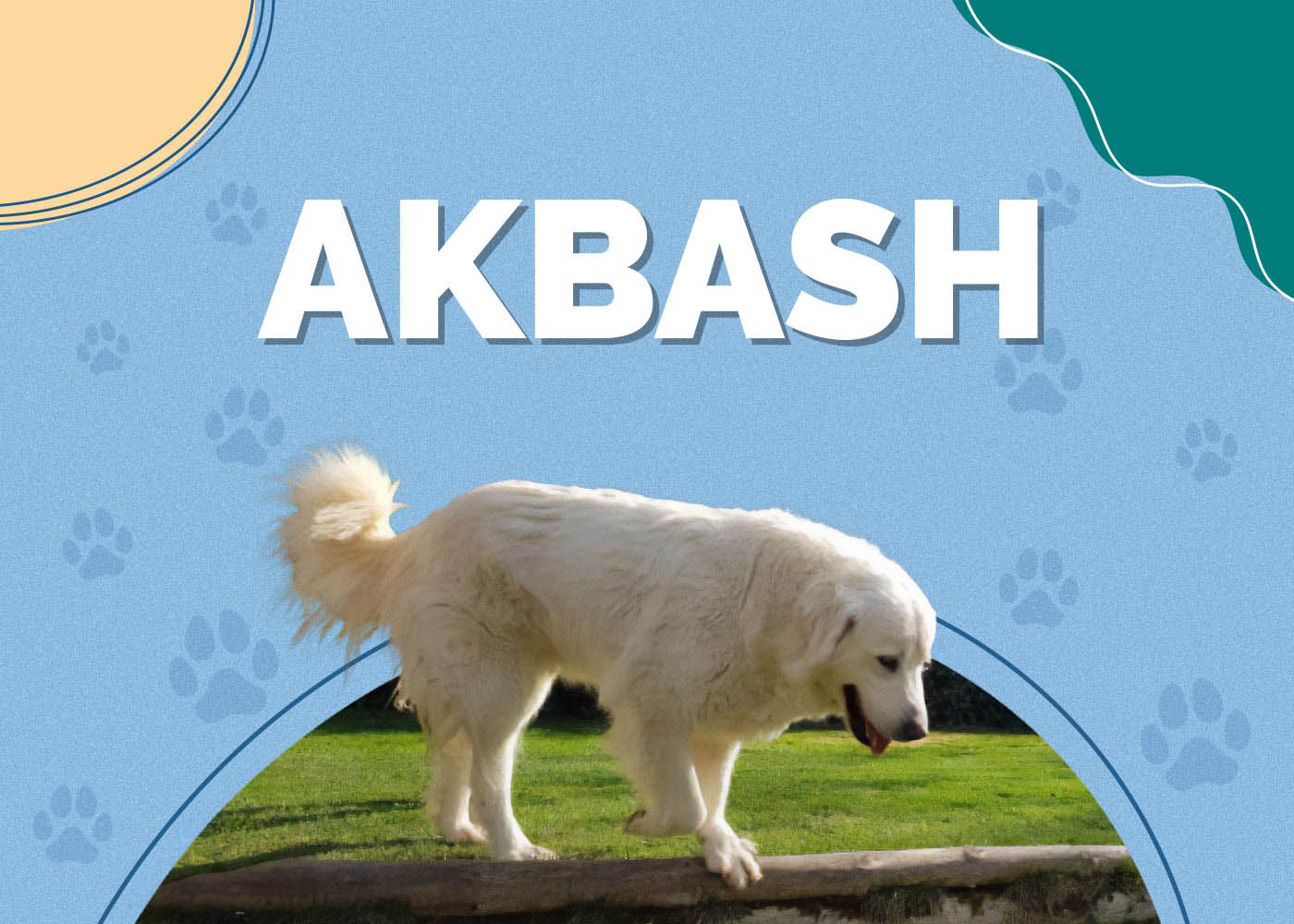Great Pyrenees & German Shepherd Mix: Info, Pictures, Characteristics & Facts
Updated on
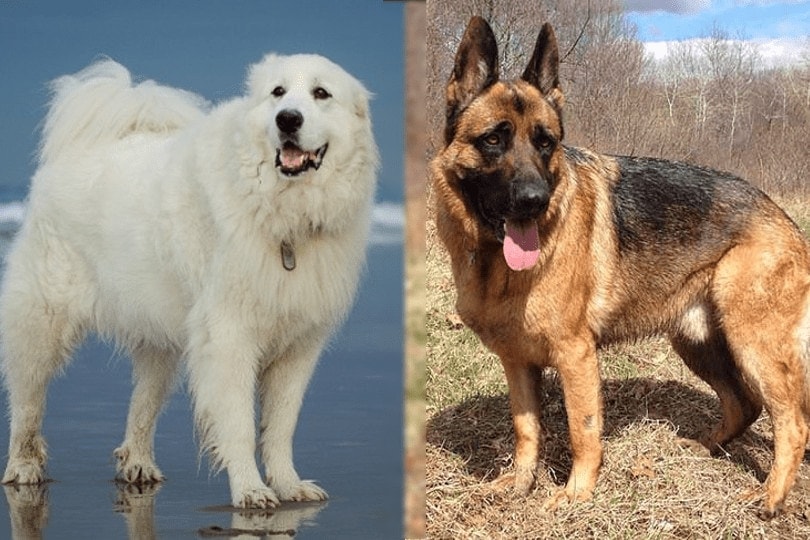
| Height: | 22-32 inches |
| Weight: | 75-120 pounds |
| Lifespan: | 9-12 years |
| Colors: | Multiple |
| Suitable for: | Families looking for protection dogs |
| Temperament: | Devoted, gentle, protective |
When you get Great Pyrenees mixed with a German Shepherd (also known as a Germanees), you never can be sure what you’ll end up with.
A mixed-breed puppy can inherit any trait from either parent. Therefore, they may be very similar to a Great Pyrenees or a German Shepherd. Usually, they’re somewhere in the middle. There can be huge differences even amongst littermates.
Normally, these dogs are bigger than your average German Shepherd. However, how big they get can vary by quite a bit!
They will likely have strong protection instincts, as both the Great Pyrenees and German Shepherd were bred to guard. These instincts must be tempered by training and socialization.
We only recommend these dogs for those with some dog-owning experience. These canines simply require too much attention and training for most first-time owners. They are also pretty high-maintenance when it comes to their temperament.
Great Pyrenees & German Shepherd Mix Puppies
Some mixed breeds are pretty popular and even have breeders dedicated explicitly to producing them. However, the Great Pyrenees and German Shepherd mix does not fall into this category.
They are a rarer mixed breed with a low supply and demand. Most people do not consider them when looking for a new puppy, so breeders often don’t produce them. At the moment, there are very few breeders in the United States that breed these puppies, even when you consider those that breed do so only occasionally.
Most of these dogs are going to be rescues and the result of accidental litters. For this reason, the puppies are usually lower-quality. Their parents didn’t undergo any health testing or receive the proper medical care.
3 Little-Known Facts About the Great Pyrenees & German Shepherd Mix
1. This Breed Is Extremely Protective
Both parent breeds have powerful protective instincts, so it is very likely that their puppies will as well! If you’re looking for a protective canine, this trait will likely come as a boon. However, these dogs are also very suspicious of strangers. This trait isn’t always best for family dogs.
2. They Require Significant Amounts of Training
Training is required to keep this dog’s protective instincts in check. You may want them to protect your family from potential dangers, but without training, they’ll likely try and protect you from the wrong things. If you want to utilize those instincts, training is necessary. Otherwise, these dogs can become highly off-putting towards strangers and even aggressive.
Plus, they are brilliant animals that will quickly become bored without the stimulation training provides.
3. Finding Them Is Difficult
These dogs are not an official breed, so there is no official breed registry of puppies. Finding breeders can be difficult, especially without any sort of database to search in. Usually, these dogs are the products of accidental litters or backyard breeders who just happened to own both parent breeds. In the end, this often leads to lower-quality puppies.
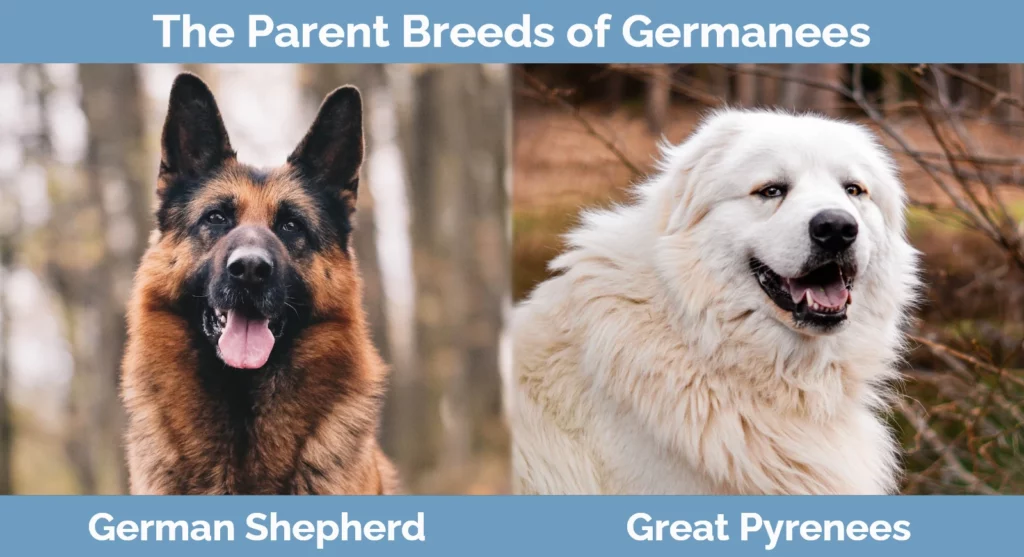
Temperament & Intelligence of the Great Pyrenees & German Shepherd Mix 🧠
First and foremost, these canines will be highly protective of their owners and family. Both parent breeds were initially bred to guard people and property – a trait this mixed breed will likely inherit. Just how protective these dogs vary. You don’t know what instincts they will inherit from which parent. They will not be as predictable as purebred dogs. That simply isn’t how mixed breeds work!
They are often described as fearless, which means that they can easily stand up to most threats. However, this can also make them somewhat reckless and hard to control. They aren’t always scared of traffic, for instance.
They need plenty of training, but they are pretty easy to train – luckily. We recommend puppy classes starting at an early age. Preferably, you should use these group classes to train and socialize your puppy. If you start early, you typically don’t need to worry about your dog needing private classes. However, this dog will likely not have the same level of trainability that the German Shepherds have. The Great Pyrenees is a bit stubborn, after all.
These dogs are known for barking. They tend to alert on anything they think is suspicious, including the mailman and anyone walking by outside. They are a bit higher strung than other dogs and may be more prone to separation anxiety.
You should expect this mixed breed to be highly energetic and playful. They tend to bond through play, so they may end up bringing a toy to you instead of cuddling on the couch. They usually won’t need as much exercise as the German Shepherd, though. However, the exact amount of energy they have varies. Some may be rug-dogs and spend most of their time laying around. Others may remain extremely energetic throughout their lives.
Are These Dogs Good for Families? 🏡
Yes, as long as they are adequately trained.
Their large size makes them a good option for small children. Often, small dogs are inappropriately considered the best option for children. However, this is not the case.
Small dogs are easily injured by smaller children, causing them to retaliate and bite. They can also become scared of children very quickly, especially if they are injured. As you might imagine, an easily hurt, a scared dog is not best for a toddler!
Large dogs don’t have either of these problems. A 20-pound child is likely not going to injure an 80-pound dog. Bigger dogs are also more confident around little kids since they know they can’t be hurt.
Overall, this mixed breed seems to put up with a lot from little kids! They are very gentle with their family members, even if they tend to be a bit aloof towards strangers.
Does This Breed Get Along With Other Pets? 🐶 😽
They can. They can be protective against other pets unless they are appropriately socialized. Just like with people, these dogs tend to be territorial with strange dogs. They don’t usually have a problem with dogs in their household, though.
If you want this mixed breed to get along with strange dogs, socialization is essential. We highly recommend putting them in puppy classes with many different dogs and taking advantage of dog parks.
The more you get them around other canines, the less territorial they will be. Make meeting new dogs a regular thing, and your canine won’t feel the need to worry about protecting their territory for them “trespasser.”
Whether or not this breed gets along with other pets is hit-or-miss. German Shepherds tend to have a strong prey drive, so they will chase cats and similar animals. However, Great Pyrenees do not. Therefore, whether or not this mixed breed does is up in the air.
In most cases, this breed will do fine with other pets if they are socialized with them from an early age. You want to get your dog around cats and other small animals as a puppy. That way, when they come across them as adults, they won’t assume that they’re prey.
Things to Know When Owning a Great Pyrenees & German Shepherd Mix:
Food & Diet Requirements 🦴
For the most part, this breed will not have any specific dietary requirements. They can eat the same commercial dog foods that other breeds can. However, we do recommend feeding them high-quality food. Plus, they will eat a lot, so be sure you can afford to feed them before you commit to adopting one. Their food can easily cost a couple hundred a month.
We recommend feeding large-breed puppy food and only large-breed puppy foods when these dogs are growing. Larger dogs have different requirements when puppies than small-breed dogs. If fed incorrectly, they can develop health problems later on.
For instance, the higher levels of calcium found in smaller-breed dog food have been linked to a higher chance of hip dysplasia in large breeds. Therefore, be sure to feed your canine specifically a large-breed puppy food, and keep them on it until they are full-grown, which may take a few years!
After they grow into adulthood, these dogs may still benefit from large-breed food. Often, these include nutrients like glucosamine and omega fatty acids – which can be particularly beneficial for larger breeds.
If your dog develops specific health problems, we do recommend choosing a food designed to conquer those health issues. Many conditions can be controlled somewhat through diet.
Exercise 🐕
The exercise requirements of this breed vary greatly. German Shepherds are extremely energetic. They need hours of exercise each day. After all, they are working dogs through and through and were bred to spend much of their time in the field. We only recommend purebred German Shepherds for active owners – for a good reason.
However, the Great Pyrenees is far more laid back. Like most larger dogs, they don’t actually move very much. Instead, they spend much of their time lying around, though they can produce bouts of energy if required. Their guarding style typically involves laying around until something happens.
This mixed breed can be on either end of the spectrum. They may be extremely active, or they could be significantly less so. It just depends on what traits they inherit.
We don’t recommend getting one of these puppies unless you can commit to a few hours of exercise a day. However, don’t be surprised if your dog actually needs much less. Follow your dog’s lead on their exercise needs. There are some obvious signs that your dog needs more exercise, like excess jumping and running around indoors. However, general destructive behaviors can also be a sign that your dog isn’t getting enough exercise.
Never force-exercise your dog, especially as a puppy. While you can expect these canines to need a bit of exercise, you shouldn’t force them to walk a certain amount each day. This practice can damage their legs and joints. Dogs are much more likely to develop problems later on if they were forced to move too much.
Puppies are particularly susceptible to over-exercise. Their joints are still developing, and too much movement can cause problems. Furthermore, puppies may be very energetic, but their endurance is usually quite low. You can’t expect a puppy to walk for an hour at a time. However, you can expect them to walk for 15 minutes a few times a day.
As always, follow your dog’s lead. If they’re panting up a storm and laying down, it’s time to call it a day!
Training 🦮
Training is a requirement for this breed. Plan on training them extensively well into their adult years. There isn’t a time where you’ll be able to stop training. Be sure you can commit to at least 30 minutes a day for the rest of the dog’s life.
Training should begin as early as possible. We recommend starting your puppy in group puppy classes as soon as they have all their shots. Most places won’t let you enroll before then, and you shouldn’t want to put your puppy at risk for deadly diseases just to start training a bit earlier!
You can begin training at home before your puppy has all its shots. Even a puppy that’s a few weeks old can be trained, though sessions should be kept short and easy. We do not recommend skipping puppy classes, even if you’ve trained dogs before. This mixed breed requires extensive socialization, and puppy classes are an easy way to accomplish that. Of course, you should utilize other methods of socialization as well, such as walking in parks and taking your pet to dog-friendly stores.
Begin with basic techniques. As a more intelligent breed, your Germanees should master these quickly. Be sure to practice in a variety of situations with distractions. A dog that can sit in your living room on command won’t necessarily be able to when they are out on a walk. Even after your dog has accomplished these easier commands, you should continue training.
The Great Pyrenees German Shepherd mix is extremely intelligent. They need mental stimulation daily to stay healthy and happy. Otherwise, they can easily become destructive and attempt to make their own fun (which often involves chewing through your wall or learning how to open all your cabinets). Training is an easy way to work their brain. Running out of commands to teach will probably end up being a serious concern. You’ll likely need to move onto “tricks” like jumping through hoops and “playing dead” at some point.
You can mentally stimulate your dog through other means as well. Training just happens to be one of the easiest methods.
Grooming ✂️
Coat type will vary greatly from dog to dog, as will grooming. If your canine has a thicker coat, you may need to brush them daily. Typically, these dogs will shed quite a bit. We highly recommend brushing them as much as possible, even if their coats are shorter. Their shedding can get out of control very quickly. Plus, the more you groom them, the more accepting of the process the dog will be.
A de-shedding tool is sometimes helpful for extremely heavy shedding periods. However, many people get away with a pin brush instead, especially if your dog’s fur is shorter.
Your dog will not need a full-body trim. You should keep their fur longer, even in hotter climates. Trimming can mess with their ability to regulate their body temperature, especially if it is done regularly. However, you will need to trim inside their ears, around their eyes, and on the bottom of their feet. The longer fur in these locations can cause issues and should be removed. You can do this yourself easily at home or take your pooch to a groomer to do it.
You should trim their nails regularly – just like you would any dog. Brushing their teeth a few times a week is also necessary. Otherwise, periodontal problems can pop up.
Health and Conditions
As mixed breed dogs, these canines are usually healthier than most others. They inherit from a larger gene pool, which makes genetic conditions much rarer. However, they are still prone to a few issues.
Hip Dysplasia
The most serious and common of these is hip dysplasia. This condition affects the growth of the hips in puppies. For some reason, the socket and ball stop growing at the same rate, making them unaligned. Eventually, this creates wear-and-tear, similar to arthritis.
This condition does have a genetic component. If a dog’s parent has severe hip dysplasia, they are much more likely to get it, too. However, environmental factors also play a role. For instance, dogs that are overfed or fed the incorrect food are more likely to end up with hip dysplasia. Overexercise can also be a contributing factor.
Bloat
Bloat is a condition that causes the stomach to swell with gas, usually for a completely unknown reason. Not much is known about this illness. We don’t know exactly what causes it in most cases, nor what can be done to prevent it.
This condition strikes quickly and can kill a dog in a matter of hours. The signs can seem quite unserious, though. Sometimes, dogs just act a bit uncomfortable until their stomach swells so much that they go into shock. The swelling is somewhat visible from the dog’s stomach. However, it is usually not so noticeable that it prompts owners to see veterinary attention.
As an owner of a larger dog, it is vital to know the signs of this condition and stay on the lookout for them. Quick vet care is essential to recovery without any long-term effects.
Von Willebrand’s Disease
This illness is a genetic condition that affects clotting. If a dog is affected by this problem, they usually do not clot correctly. As you might imagine, this can cause serious bleeding problems!
There isn’t a cure for this genetic condition. However, it is important to diagnose it. You don’t want a dog that can’t clot being up under for surgery without knowing! Knowledge is power in this situation, even if you can’t cure the disease outright.
Usually, this condition is noticed when the dog gets injured or undergoes minor surgery. Dogs that are spayed or neutered often get diagnosed earlier than dogs that are not simply because the bleeding is noticed during the surgery.
To prevent this disease, breeders often genetically test both parents. You can prevent this condition by not breeding two dogs with the gene together. However, because this mixed breed isn’t often bred by breeders, they often don’t undergo this sort of testing.
Male vs. Female
There is no difference between the two genders of this breed. The sizing difference that may be apparent with both their parents disappears when you mix them together. Puppies simply differ too much in size for a distinction between gender to develop.
Temperament doesn’t seem affected by gender, either. Obviously, females will go into heat if they aren’t fixed, which will affect their behaviors for a bit. Males may act a bit different if they notice a female nearby in heat – even if they only catch her scent on a nearby tree.
For the most part, there is no serious difference between these genders.
Final Thoughts
This German Shepherd Great Pyrenees mixed breed can be a handful. They are very protective of their family and property, which can make them aggressive towards strangers. However, training and socialization can help get around this. You just need the time and patience for this vital socialization. Otherwise, they can become aggressive towards those they don’t know.
This canine is great for families and children. They can even be socialized to get along with other pets. However, all of this will require work on the owner’s part.
We only recommend this breed for those who have plenty of time to dedicate to them. It also helps if you’re more on the active side, as this mixed breed may require significant amounts of exercise.
Featured Image Credit: Left – everydoghasastory, Shutterstock; Right – profcalamitous, Pixabay





